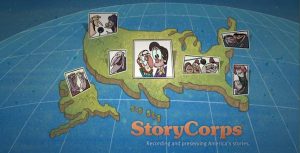StoryCorps Shorts: Dave Isay Interview

StoryCorps Founder and President Dave Isay. Credit: Harvey Wang
POV: The StoryCorps project started in 2003. How did the StoryCorps project start? What was your goal with the project?
Dave Isay: StoryCorps grew out of a very a simple idea: we wanted to provide Americans of all backgrounds and beliefs with the opportunity to record their life stories. We built a soundproof booth in Grand Central Terminal and invited people to come in pairs and interview each other about their lives, with the help of a trained StoryCorps facilitator. Soon after starting the project, I knew we had created something pretty powerful. Many StoryCorps participants tell us that the forty minutes they spend inside our booth are among the most meaningful minutes of their lives. We hope to grow StoryCorps into a national institution that touches the lives of every American family
POV: How many recordings has the project made so far? Where have you recorded?
Isay: We’ve recorded more than 30,000 interviews with more than 55,000 participants in all 50 states and archived them in the American Folklife Center at the Library of Congress.
POV: As a radio documentary producer, you’ve created memorable pieces about people in their everyday lives. With StoryCorps, you hand over the interviewing and storytelling to Americans who ask their own questions. Do you or your staff provide coaching during this process? Are there any lessons that you’ve learned from the interviews that they have conducted?
Isay: The most important thing that StoryCorps does is offer our participants a safe place to open up and talk about their lives. The facilitators play many roles, but chief among them are listener and witness. We see everyday that being interviewed by a loved one reminds participants that they matter and won’t be forgotten. One of the things I understood from my days making documentaries and has proven true time and time again through StoryCorps is that a microphone gives people the license to have important conversations and to ask important questions that we don’t normally get to ask.
POV: Why do you think it’s important for people to record their stories?
Isay: With each StoryCorps interview, participants have the chance to leave a legacy — so that their great, great grandchildren will get to know them through their voices and stories. The StoryCorps experience reminds us that if we take the time to listen, we’ll find poetry wisdom and magic in the stories of the people we find all around us.

Lower Manhattan StoryBooth at Foley Square. Credit: Dalton Rooney
POV: What types of people come to the booth? What are the most common topics these interviews cover? Any surprising ones?
Isay: In 30,000 interviews, we’ve had every imaginable kind of person participate—from prisoners at the Louisiana State Penitentiary (where we were recording last week) to members of Congress and even a U.S. president. Because these interviews provide the opportunity to leave a legacy in 40 minutes, most people talk about the great themes of human existence: birth, death, and love. I’ve learned that no matter where we come from, there’s so much more we share in common than divides us.
POV: What has surprised you about the project generally? Has it surpassed your expectations in any way?

Katie McGowan in the StoryCorps booth. Credit: Tony Rinaldo
Isay: I’m amazed every day at the impact that recording and listening to these interviews makes on people’s lives. This is a project that—I hope—restores and strengthens people’s faith in humanity. It certainly has mine.
POV: Do you think there a particular relevance to doing this project now, at this moment in history?
Isay: I’m wary of being nostalgic. I do believe that listening and recognizing our shared humanity is important at any and every time in history—and that if we as a country spent a little more time listening to each other and little less time shouting, we’d be a better, more thoughtful and more compassionate nation.
POV: StoryCorps recordings are archived in the Library of Congress as oral histories of American life, but only a selection of interviews are available on the StoryCorps website. Are there any efforts to make more of these recordings available online?
Isay: We are currently working on a new web-based archive that we expect to be available online in 2012.
Watch the video interview:
 StoryCorps Shorts: Explore the StoryCorps Animated Shorts
StoryCorps Shorts: Explore the StoryCorps Animated Shorts  The Apology: Filmmaker Statement
The Apology: Filmmaker Statement  Still Tomorrow: Film Update
Still Tomorrow: Film Update  Featured Event: 'QUEST' film screening with Company One and ZUMIX
Featured Event: 'QUEST' film screening with Company One and ZUMIX